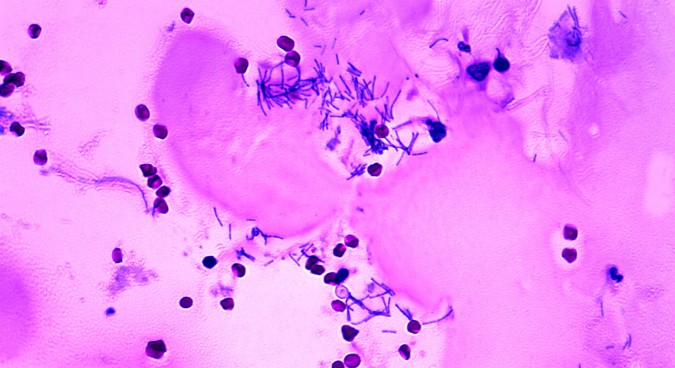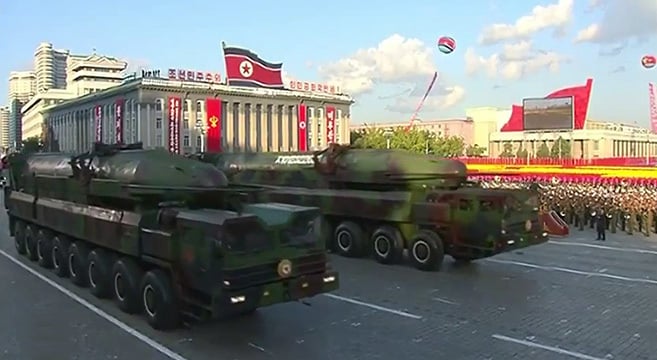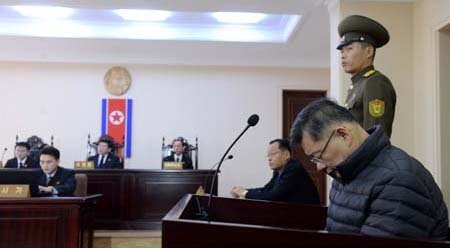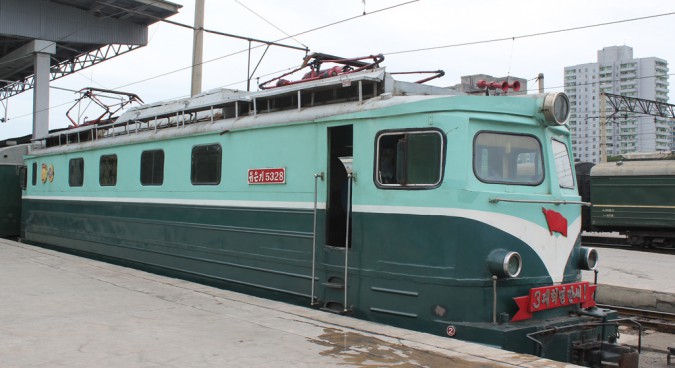The KN-08 mobile missile system on display at the October 10, 2015, parade in North Korea is significantly different from the KN-08 missiles displayed at all previous parades. The changes visible in the KN-08 design include a shortened missile, either a new nosecone or a shroud, and indicate a possible basis on the Russian R-29R missile. It is apparent that North Korea is continually researching and upgrading its ballistic missile designs.
Assuming these differences are real and not simply models or deceptive false alterations, the KN-08, appears significantly shorter, indicating the elimination or redesign of later stages. Additionally, it has a radically different nosecone that could be indicative of guidance systems based on Russian technology. In the best case scenario, it is either a cosmetic cover for the purposes of the parade or a shroud for protecting the reentry vehicle (RV, colloquially referred to as the warhead) during ascent. The data cabling along the side has also changed, though this is a much more minor data point than the previous two.
The differences between early and current KN-08s are so great that, if both sets have been functional missiles, they should and will likely receive a different common designation from the previous KN-08 (such as KN-08 Mod 2 for example). Alternatively, since the KN-08 is not fully operational, it may be that the previous versions end up waved off as prototypes and KN-08 becomes the standard for the final product.
FINAL STAGES REDESIGNED
On Saturday’s parade the KN-08 appeared to be either shown without its reentry vehicle attached or with highly modified stages. What appeared to be a three stage missile in earlier parades now appears to only have room for two stages and a reentry vehicle, or more compact three stages that take advantage of concave fuel tanks. Various
diagrams and
analyses from the past few years have noted that the KN-08 appeared to be three clear stages, with the last booster stage being distinctly smaller than the previous two. This is no longer the case, and the entirety of the missile airframe is now roughly the same size.
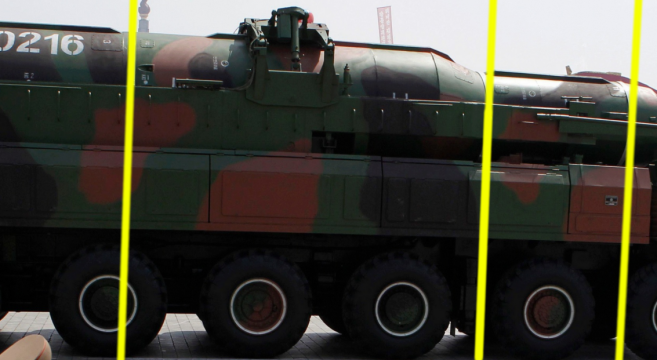
Measurements on the original KN-08 design | Zoom of detail based on photo by Chosun Ilbo, October 10, 2015, http://img.bemil.chosun.com/nbrd/data/10049/upfile/201209/20120930081926.jpg
In the first image, the three stages are delineated by the yellow lines. The pointed nosecone at the far end is the RV, which would detach from the third stage after the booster expires. After detaching, depending on the complexity of the system, either the RV would continue to travel along its ballistic trajectory or a post-boost vehicle (PBV) would make small alterations to the RV’s angle or trajectory to either correct its trajectory or fine tune it to a target.
It should be noted that “fine tuning” an ICBM RV can change its general target by several kilometers and that ICBMs are fairly inaccurate when compared to shorter-range systems and cruise missiles. The PBV or RV does not count as a fourth stage, as post-boost maneuvers are for fine tuning and guidance, not for significant additional range.
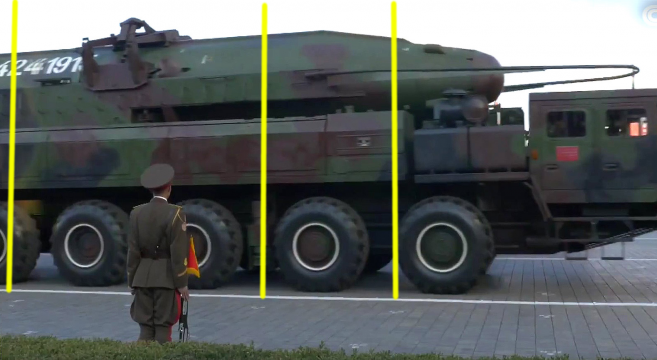
Original KN-08 measurement lines on new KN-08 | Zoom of detail based on photo by militaryrussia.ru, October 10, 2015.
In the second image, above, the yellow lines are put at the same place (based on wheel positions and markers on the TEL) to show the different size. While the third stage technically still exists, the room left in the nosecone for an RV would be very small. The third stage and post-boost stage to the right are too small to house both the RV from the original picture, which is quite long, and the third stage from the previous picture. The final stages of the missile could fit the original third stage or the original RV, but not both. However it could house either a significantly redesigned new third stage, a new RV, or both.
Comparison of the old and new KN-08 bodies indicates that either the third stage has been eliminated entirely to house the original RV or that, by using a certain type of post-boost vehicle, the third stage has been reduced in visible length. Some missile designs have accomplished this by making internal fuel tanks concave, allowing reentry vehicles or satellite packages to vertically overlap with the fuel tanks. This is a particularly useful design mechanism for designs that must be vertically compact, such as submarine-launched ballistic missiles. In the KN-08’s case, it could possibly allow for a small third stage, though this is uncertain.
The airframe is also now a more consistent size, instead of narrowing sharply at the end for the final stage and RV. This could mean that this small third stage has been replaced. Going back to the yellow lined measurements, the space for the third stage is still there, it is just much wider now and lacks the narrow RV. If the DPRK is following the design traditions of Soviet submarine launched ballistic missiles, this could still be a third stage.
The length of the body changing is notable. It would not be unreasonable to see the RV as being removed, with the third stage covered by the new nosecone and the missile remaining incomplete. This would need an RV before launch still. It could be the case that the old RV is still in use, but the missile has become a two stage system, which would significantly shorten its range. It could also be the case that the third stage has been redesigned with concave fuel tanks and a shorter RV. The most likely scenario depends entirely on what the new nosecone means. If the new nosecone is just an aesthetic cover for deceptive purposes, it is almost impossible to assess what is different, as it will have little bearing on design. If it is a shroud, a two-stage option may be the most reasonable. If it is a post-boost vehicle, a redesigned third stage is more possible.
SHROUD OR PBV?
One of the most immediately noticeable changes is the nose of the missile. It is unknown if this is just a cover, a shroud, or a Soviet-style post-boost vehicle. A cover would just be a temporary fitting to mask the actual design of the end of the missile, similar to how certain engines are covered with large red or white coverings during parades to prevent further analysis. A shroud is the partially hollow nosecone of a ballistic missile that covers the reentry vehicle and other sensitive instruments during its ascent into space. Once in space, the shroud is jettisoned off, usually with very small rocket motors attached to it. A post-boost vehicle is a small platform that activates when the boost-phase of the missile ends. The PBV has small rocket motors or other means of propulsion that allow it to maneuver in space to better aim the reentry vehicle or vehicles.
Several Soviet-designed missiles, including some members of the R-29 (SS-N-8/18) SLBM family and the R-36M (SS-18), the R-39 (SS-N-20), and the Bulava (SS-N-30/21) have a “backwards” PBV, that is, one where the RV or RVs are on the bottom of the PBV facing into the body of the missile. This is the opposite of the more common forward facing PBVs. These “backward” PBVs still work very similarly to “forward” PBVs, just with some of the maneuvers reversed. Both work to make slight adjustments to the ballistic trajectory of the reentry vehicle or vehicles. This type of PBV can be used for both single and multiple warhead missiles.
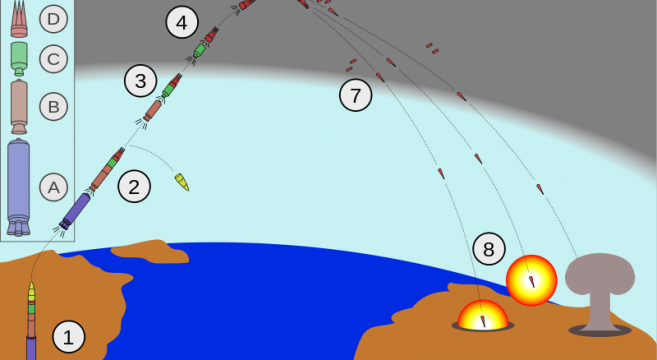
Minuteman III MIRV launch sequence | Image: Wikimedia Commons
Wikipedia actually has a fairly
useful diagram of what shrouds and PBVs are. From this diagram’s PBV it is possible to diagram out the PBV/bus with backwards facing RVs for clarification purposes. Red indicates the post-boost vehicle/bus, in this case a MIRV bus from a Minuteman III, while the yellow indicates the shroud that covers the missile during ascent. While this example is of a MIRV PBV, non-MIRV missiles can also have PBVs for more precise guidance.
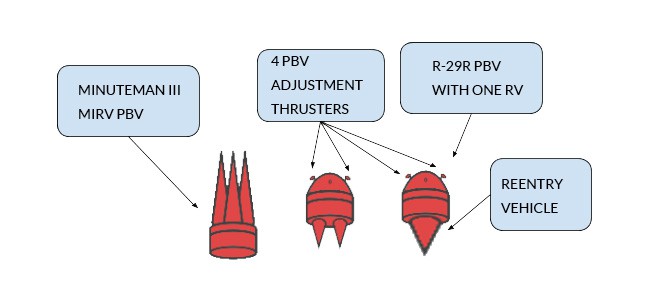
The above picture is an example of forward and backwards facing post-boost vehicles. It is not to scale and is just meant to show the difference between the two buses. The forward facing one requires a shroud in most cases, while the backwards facing PBV acts as its own shroud. | Composite image of elements from images on Wikimedia Commons.
The four small extrusions on the nosecone would be arbitrary for a cover. While they do not, on their own, prove or disprove what the nosecone is, they do look like radially mounted nozzles for thrust. If this would be the case, both a shroud and Soviet-style PBV are possible. Shrouds need small motors to remove them from the missiles. Some shrouds have small, radially mounted nozzles while others have small, internal motors. In this case, the four small shapes on the nosecone would be external nozzles that would propel the shroud out of the way of the reentry vehicle.
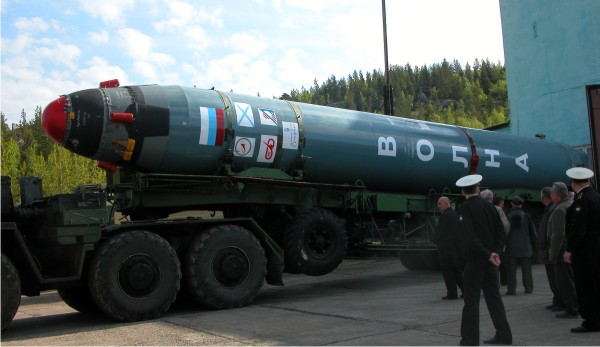
Russian R-29R Volna-1 | Photo: Open Joint Stock Company “Academician V.P.Makeyev State Rocket Centre”, http://www.makeyev.ru/rocspace/rkkvolna/
As far as a post-boost vehicle goes, there is only one missile with a PBV visually similar to the KN-08 nosecone, as far as this author is aware. The R-29R Volna, a Soviet submarine-launched ballistic missile that is now being used as a commercial space launch platform, has radial nozzles very similar to the shapes on the KN-08. Other members of the R-29 family have nosecone nozzles, but they are of significantly different shape. Images of the R-29R vary, with some having very similar nozzles and others having slightly different nozzles, so even among R-29Rs there are some that look different from the KN-08. Joost Oliemans and Stijn Mitzer also pointed out visual similarities in an
earlier article.

Russian R-29R Volna-1 | Photo: Open Joint Stock Company “Academician V.P.Makeyev State Rocket Centre”, http://www.makeyev.ru/roccomp/3rd/r29r
The R-29R nose is not identical to the KN-08, but it is very similar. While by no means definitive, this is the only missile technology that seems to be similar to the KN-08’s design. If this is a PBV and not a shroud, this nosecone will separate from the final stage and use these nozzles to maneuver and fine tune its guidance and targeting as much as possible. While this technology is already decades old, guidance is very difficult to get right, especially for long-range systems. The DPRK’s lack of operational testing of long-range missile systems makes the PBV assessment less likely.
If this were to be confirmed as an R-29R based or inspired post-boost vehicle, the DPRK would not only be far ahead of where open source analysts expect their guidance systems to be, but they would also have a solid basis for producing MIRVs. This would represent a significant and unexpected leap ahead in DPRK missile technologies, which again makes this PBV option less likely
Going back to the yellow-lined measurement photographs, notice the space for the third stage. Earlier it was mentioned that a third stage was possible only if modified. If the missile had the backwards-facing post-boost vehicle, a third stage could conceivably still fit in the space if it had concave fuel tanks. Certain members of the R-29 family and other SLBMs had deeply concave fuel tanks that formed a sort of pocket large enough for the RV or satellite package to be stored in. Since the PBV was on top of the RV, it pulls the RV forward and out of the small pocket and begins maneuvering. While several members of the R-29 family were only two stage missiles, it is a technology that could be applied to three stage missiles.
In short, if the nosecone is actually a post-boost vehicle, then the warhead would be kept “inside” the third stage. If the nosecone is actually a shroud, then there is less space available for a third stage. There still could conceivably be a small third stage, but it would mean that the RV seen in the earlier parade was not being used anymore or was a fake to begin with. There is, fairly obviously from the pictures, not enough room for a third stage and the old RV. There is enough room for new versions of each, however. If the nosecone is just a cover, there is no way to tell what has happened with the upper stages.
UPGRADED DATA CABLES?
A final difference is the cabling along the side of the missile airframe. In the earlier parades, this cabling was broken up among the three stages. The current KN-08 has a single line running the length of its body. Unfortunately, imagery from the current parade is incomplete and it is questionable if it is actually a single line or two lines. It appears to be a single line, but this observation may be corrected as new imagery is released.
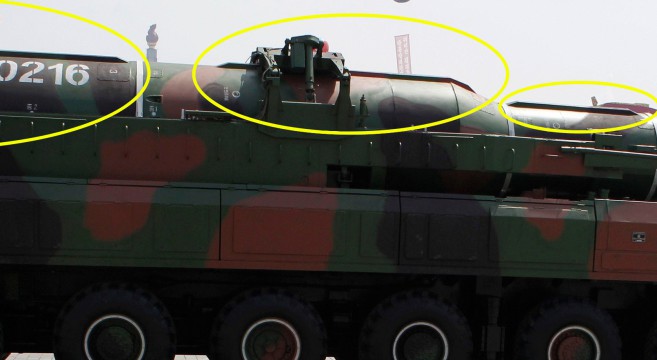
Data cables on the original KN-08 | Zoom of detail based on photo by Chosun Ilbo, October 10, 2015, http://img.bemil.chosun.com/nbrd/data/10049/upfile/201209/20120930081926.jpg
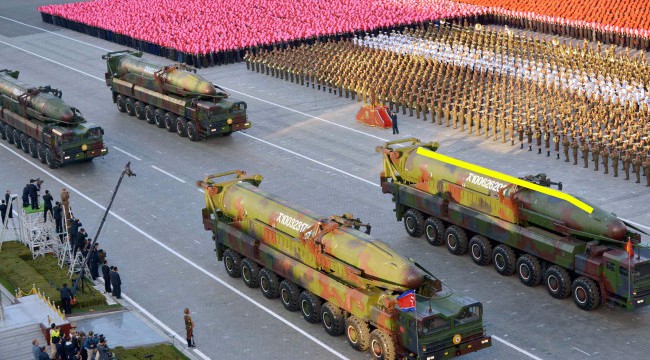
Data cables on the new KN-08 | Based on photo by Korea Herald, October 10, 2015, http://res.heraldm.com/content/image/2015/10/11/20151011000200_0.jpg
SUMMARY & CONCLUSIONS
It is important not to jump to extreme conclusions from minimal information. The nosecone and length of the KN-08 as examined here are not conclusive, though they may be indicative of certain design choices. A few important details to take from the parade:
- The KN-08’s length reduced noticeably, possibly meaning:
- The RV from earlier parades was not mounted in the 2015 parade
- The previously seen third booster stage is no longer used
- The third booster stage has been widened and made concave to fit a new RV/PBV design
- The KN-08’s nosecone is radically different and could be:
- A purely aesthetic addition for the parade to cover up either a new design or an incomplete design, making analysis difficult
- A shroud to cover the RV during ascent. The nozzles on the side are for shroud flyoff.
- A “backwards” post-boost vehicle similar to the R-29R. The nozzles on the side are for maneuvering and more precise guidance
- This could indicate that the fuel tank in the final stage is concave, meaning a small third stage could hypothetically be squeezed in.
- The data cabling down the side is different
- Earlier design had cable for each stage
- Current design has one cable running the length of the airframe
Main additional data needed:
- Hi-resolution imagery
- Specifically more imagery of the verniers, which will help determine whether or not it is still a three stage missile
- Better imagery comparisons of the R-29R
- Imagery is generally poor, but the few good images do show additional nosecone features that do not exist on the KN-08
With this in mind, there is a lot of rampant speculation that could occur. Realistically all we know is that the length, nosecone, and data cablings were different. There are some similarities to the R-29R Volna missile, mainly in nose cone design, indicating that there could be some sort of relationship between the two missiles. It is entirely speculative what this relationship could be, however. It could be a mockup based on the Volna, technical assistance could have been rendered by state or rogue elements of the Russian military, or it could be a shroud that just looks like a complex guidance platform. Unfortunately, in this case a simple metal cover that encases a warhead and a complex guidance platform look fairly similar.
It could be that the KN-08 previously relied on a forward facing PBV or no post-boost vehicle at all, but found a backwards facing PBV somehow beneficial enough to warrant a redesign of both the reentry vehicle and the third stage. It could be that the third stage and RV of the initial missile were even faked to look like other modern missile designs. There is a lot of speculation, but unfortunately minimal data. Hopefully more imagery and information comes out in time.
Featured image: Redesigned KN-08s in a parade in Pyongyang, October 10, 2015 | Main photo: KCTV
